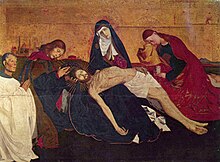Avignon School

The Avignon School ( fr. École d'Avignon) can be summarized as the style of works of art that emerged at the court of the Popes in Avignon in France and its surroundings when the Popes had their residence in Avignon from 1309 to 1411.
For example, around 1350 the Italian painters Simone Martini and Matteo di Giovanetto da Viterbo came to Avignon and gathered a number of local artists such as Robin de Romans around them. In Avignon a fusion of the Italian and French styles of painting of the time emerged.
In terms of style, the city of Avignon remained a certain Italian enclave within France until the 15th and 16th centuries. Artists of the Avignon School, such as Barthélemy d'Eyck , Nicolas Froment and Enguerrand Quarton produced important works of art at that time, such as For example, the Pietà by Villeneuve-lès-Avignon from 1455, which can be seen today in the Louvre in Paris and is considered one of the masterpieces of painting in France in the Middle Ages.
In the Musée du Petit Palais in Avignon in particular, a number of other works of art created by the Avignon School can be seen today.
literature
- Gabriel Colombe: La Palais des Papes d'Avignon . Paris 1927
- Enrico Castelnuovo: École d'Avignon . In: Art de France I (1961), pp. 283-287
- Michel Laclotte, Dominique Thiébaut: L'École d'Avignon; la peinture en Provence aux XIVe et XVe siècles . Paris 1963
- Sylvain Gagniere: The Papal Palace of Avignon . Paris 1965
- Michel Laclotte, Esther Moench: Italian Peinture: Musée du Petit Palais Avignon . Avignon 2005
- Avignon School . In: The great art lexicon by PW Hartmann (online edition 2011)
- Thorsten Droste: Provence art travel guide: A companion to the art sites and natural beauties in sunny France . Cologne 2009